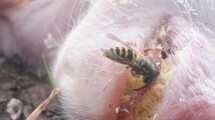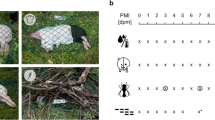Abstract
Understanding the onset and duration of adult blow fly activity is critical to accurately estimating the period of insect activity or minimum postmortem interval (minPMI). Few, if any, reliable techniques have been developed and consequently validated for using adult fly activity to determine a minPMI. In this study, adult blow flies (Diptera: Calliphoridae) of Cochliomyia macellaria and Chrysomya rufifacies were collected from swine carcasses in rural central Texas, USA, during summer 2008 and Phormia regina and Calliphora vicina in the winter during 2009 and 2010. Carcass attendance patterns of blow flies were related to species, sex, and oocyte development. Summer-active flies were found to arrive 4–12 h after initial carcass exposure, with both C. macellaria and C. rufifacies arriving within 2 h of one another. Winter-active flies arrived within 48 h of one another. There was significant difference in degree of oocyte development on each of the first 3 days postmortem. These frequency differences allowed a minPMI to be calculated using a binomial analysis. When validated with seven tests using domestic and feral swine and human remains, the technique correctly estimated time of placement in six trials.

Similar content being viewed by others
References
Carter DO, Yellowlees D, Tibbett M (2007) Cadaver decomposition in terrestrial ecosystems. Naturwissenschaften 94(1):12–24. doi:10.1007/s00114-006-0159-1
Greenberg B (1991) Flies as forensic indicators. J Med Entomol 28(5):565–577
Motter MG (1898) A contribution to the study of the fauna of the grave. A study of one hundred and fifty disinterments, with some additional experimental observations. JN Y Entomol Soc 6(4):201–231
Rodriguez WC, Bass WM (1983) Insect activity and its relationship to decay rates of human cadavers in East Tennessee. J Forensic Sci 28(2):423–432
Reed HB Jr (1958) A study of dog carcass communities in Tennessee, with special reference to the insects. Am Midl Nat 59(1):213–245
Payne JA (1965) A summer carrion study of the baby pig Sus scrofa Linnaeus. Ecology 46(5):592–602. doi:10.2307/1934999
Tomberlin JK, Mohr R, Benbow ME, Tarone AM, VanLaerhoven SL (2011) A roadmap for bridging basic and applied research in forensic entomology. Annu Rev Entomol 56(1):401. doi:10.1146/annurev-ento-051710-103143
George KA, Archer MS, Toop T (2013) Abiotic environmental factors influencing blowfly colonisation patterns in the field. Forensic Sci Int 229(1–3):100–107. doi:10.1016/j.forsciint.2013.03.033
Matuszewski S, Szafałowicz M (2013) Temperature-dependent appearance of forensically useful beetles on carcasses. Forensic Sci Int 229(1–3):92–99. doi:10.1016/j.forsciint.2013.03.034
Matuszewski S, Szafałowicz M, Grzywacz A (2013) Temperature-dependent appearance of forensically useful flies on carcasses. Int J Legal Med:1-8. doi:10.1007/s00414-013-0921-9
Mohr RM, Tomberlin JK (2014) Environmental factors affecting early carcass attendance by four species of blow flies (Diptera: Calliphoridae) in Texas, USA. J Med Entomol 51:702–708. doi:10.1603/ME13149
Matuszewski S (2011) Estimating the pre-appearance interval from temperature in Necrodes littoralis L. (Coleoptera: Silphidae). Forensic Sci Int 212(1–3):180–188. doi:10.1016/j.forsciint.2011.06.010
Matuszewski S (2012) Estimating the preappearance interval from temperature in Creophilus maxillosus L. (Coleoptera: Staphylinidae). J Forensic Sci 57(1):136–145. doi:10.1111/j.1556-4029.2011.01958.x
Tenorio FM, Olson JK, Coates CJ (2003) Decomposition studies, with a catalog and descriptions of forensically important blow flies (Diptera: Calliphoridae) in Central Texas. Southwest Entomol 28(1):37–45
Deonier CC (1940) Carcass temperatures and their relation to winter blowfly populations and activity in the Southwest. J Econ Entomol 33(1):166–170
Baumgartner DL (1993) Review of Chrysomya rufifacies (Diptera: Calliphoridae). J Med Entomol 30(2):338–352
Wells JD, Greenberg B (1994) Resource use by an introduced and native carrion flies. Oecologia 99(1–2):181–187. doi:10.1007/Bf00317099
Holt RD, Polis GA (1997) A theoretical framework for intraguild predation. Am Nat 149(4):745–764. doi:10.1086/286018
Gruner SV, Slone DH, Capinera JL (2007) Forensically important Calliphoridae (Diptera) associated with pig carrion in rural north-central Florida. J Med Entomol 44(3):509–515. doi:10.1603/0022-2585(2007)44[509:FICDAW]2.0.CO;2
Hall RD, Doisy KE (1993) Length of time after death—effect on attraction and oviposition or larviposition of midsummer blow flies (Diptera:Calliphoridae) and flesh flies (Diptera: Sarcophagidae) of medicolegal importance in Missouri. Ann Entomol Soc Am 86(5):589–593
Tomberlin JK, Benbow ME, Tarone AM, Mohr RM (2011) Basic research in evolution and ecology enhances forensics. Trends Ecol Evol 26(2):53–55. doi:10.1016/j.tree.2010.12.001
Catts EP, Haskell NH (1990) Entomology & death: a procedural guide. Joyce’s Print Shop, Inc., Clemson, S.C
Patrican LA, Vaidyanathan R (1995) Arthropod succession in rats euthanized with carbon dioxide and sodium pentobarbital. J N Y Entomol Soc 103(2):197–207
Schoenly KG, Haskell NH, Hall RD, Gbur JR (2007) Comparative performance and complementarity of four sampling methods and arthropod preference tests from human and porcine remains at the Forensic Anthropology Center in Knoxville, Tennessee. J Med Entomol 44(5):881–894. doi:10.1603/0022-2585(2007)44[881:Cpacof]2.0.Co;2
USNO-AAD (2011) Complete sun and moon data for one day. US Naval Observatory Astronomical Applications Department. http://aa.usno.navy.mil/data/docs/RS_OneDay.php. Accessed 28 September 2011
Berg MC, Benbow ME (2013) Environmental factors associated with Phormia regina (Diptera: Calliphoridae) oviposition. J Med Entomol 50(2):451–457. doi:10.1603/me12188
Anderson JR (1964) Methods for distinguishing nulliparous from parous flies and for estimating the ages of Fannia canicularis and some other cyclorraphous Diptera. Ann Entomol Soc Am 57(2):226–236
Bennettova B, Fraenkel G (1981) What determines the number of ovarioles in a fly ovary? J Insect Physiol 27(6):403–410
Liu D, Greenberg B (1989) Immature stages of some flies of forensic importance. Ann Entomol Soc Am 82(1):80–93
Vogt WG, Woodburn TL, Tyndale-Biscoe M (1974) Method of age-determination in Lucilia cuprina (Wied) (Diptera: Calliphoridae) using cyclic changes in female reproductive system. Bull Entomol Res 64(3):365–370
Gordh G, Headrick D (2001) A dictionary of entomology, 2nd edn. CABI, New York City
Brundage A (2011) Fitness effects of colonization time of Chrysomya rufifacies and C. macellaria, and their response to intra- and inter-specific eggs and egg-associated microbes. Texas A&M University, College Station, TX
Watson EJ, Carlton CE (2005) Insect succession and decomposition of wildlife carcasses during fall and winter in Louisiana. J Med Entomol 42(2):193–203. doi:10.1603/0022-2585(2005)042[0193:isadow]2.0.co;2
Campobasso CP, Di Vella G, Introna F (2001) Factors affecting decomposition and Diptera colonization. Forensic Sci Int 120(1–2):18–27. doi:10.1016/S0379-0738(01)00411-X
NESDIS (2011) Climatography of the United States No. 84, 1971-2000: Station #411889. National Environmental Satellite, Data, and Information Service
Davidowitz G, D'Amico LJ, Nijhout HF (2003) Critical weight in the development of insect body size. Evol Dev 5(2):188–197
Hocking B (1953) The intrinsic range and speed of flight of insects. Transactions of the Royal Entomological Society of London 104 (223-345)
Wall R (1993) The reproductive output of the blowfly Lucilia sericata. J Insect Physiol 39(9):743–750. doi:10.1016/0022-1910(93)90049-w
Roy DN, Siddons LB (1939) On the life history and bionomics of Chrysomya rufifacies Macq (Order Diptera, Family Calliphoridae). Parasitology 31(4):442–447
Mackerras MJ (1933) Observations on the life-histories, nutritional requirements and fecundity of blowflies. Bull Entomol Res 24(3):353–362
Jaenike J (1978) Optimal oviposition behavior in phytophagous insects. Theor Popul Biol 14(3):350–356. doi:10.1016/0040-5809(78)90012-6
Archer MS, Elgar MA (2003) Effects of decomposition on carcass attendance in a guild of carrion-breeding flies. Med Vet Entomol 17(3):263–271
LeBlanc HN, Logan JG, Amendt J, Goff ML, Campobasso CP, Grassberger M (2009) Exploiting insect olfaction in forensic entomology. In: Current concepts in forensic entomology. Springer Netherlands, pp 205-221. doi:10.1007/978-1-4020-9684-6_11
Vass AA, Smith RR, Thompson CV, Burnett MN, Dulgerian N, Eckenrode BA (2008) Odor analysis of decomposing buried human remains. J Forensic Sci 53(2):384–391. doi:10.1111/j.1556-4029.2008.00680.x
Ashworth JR, Wall R (1994) Responses of the sheep blowflies Lucilia sericata and L. cuprina to odor and the development of semiochemical baits. Med Vet Entomol 8(4):303–309. doi:10.1111/j.1365-2915.1994.tb00093.x
Lam K, Babor D, Duthie B, Babor EM, Moore M, Gries G (2007) Proliferating bacterial symbionts on house fly eggs affect oviposition behaviour of adult flies. Anim Behav 74:81–92. doi:10.1016/j.anbehav.2006.11.013
Wall R, Warnes ML (1994) Responses of the sheep blowfly Lucilia sericata to carrion odor and carbon dioxide. Entomol Exp Appl 73(3):239–246
Spradbery JP (1979) Reproductive status of Chrysomya species (Diptera: Calliphoridae) attracted to liver-baited blowfly traps in Papua New Guinea. J Aust Entomol Soc 18:57–61
Huntington TE, Higley LG (2010) Decomposed flesh as a vitellogenic protein source for the forensically important Lucilia sericata (Diptera: Calliphoridae). J Med Entomol 47(3):482–486. doi:10.1603/me09052
Wajnberg E (2006) Time allocation strategies in insect parasitoids: from ultimate predictions to proximate behavioral mechanisms. Behav Ecol Sociobiol 60(5):589–611. doi:10.1007/s00265-006-0198-9
Peck R, Olsen C, Devore JL (2011) Introduction to statistics and data analysis. Duxbury Press
National Oceanic & Atmospheric Administration (2011) Quality controlled local climatological data (final) hourly observations table San Marcos Municipal Arpt (12979) San Marcos, TX (11/2011).
Smith KGV (1986) A manual of forensic entomology. Trustees of the British Museum (Natural History), London, England
Daubert v. Merrell Dow Pharmaceuticals, Inc (1993). US, vol 509. Supreme Court
Acknowledgments
We are grateful to the staff of the Texas State University Forensic Anthropology Research Facility for providing access to human remains, and to Dr. Jennifer Pechal and Dr. Eric Benbow for providing the sample material from Ohio. The feral hog was obtained as the remainder of a Texas A&M AUP-approved hog ectoparasite study. Roy W. Vajdak provided the pasture access. This publication represents part of RMM’s dissertation. Partial financial support for this research was provided by the Department of Entomology and Agrilife Research at Texas A&M University.
Author information
Authors and Affiliations
Corresponding author
Rights and permissions
About this article
Cite this article
Mohr, R.M., Tomberlin, J.K. Development and validation of a new technique for estimating a minimum postmortem interval using adult blow fly (Diptera: Calliphoridae) carcass attendance. Int J Legal Med 129, 851–859 (2015). https://doi.org/10.1007/s00414-014-1094-x
Received:
Accepted:
Published:
Issue Date:
DOI: https://doi.org/10.1007/s00414-014-1094-x




